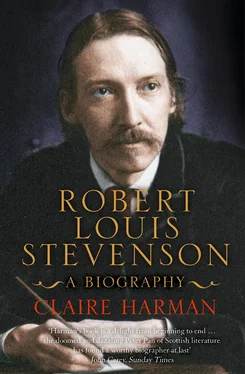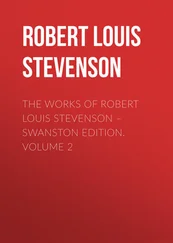THE CHANGE TO reading for the Bar did not improve Stevenson’s study habits. As Charles Guthrie recalled, ‘We did not look for Louis at law lectures, except when the weather was bad.’ 1 A notebook that survives from his law studies is peppered with caricatures and doodles, and the few notes there are on Roman citizenship segue with comical readiness into a much more engaging daydream containing lines of a later poem:
People could appear as Cognitas, on whom full [?forms] had been conferred in a form of words before the magistrate. Odonot let me sleep, kind God or let me dream of her. There is summer of the time of hearts When insolvent, gent imprisoned to make friends dub up.
O thou, still young at heart,
Still quick to see and feel,
Thou whose old arm takes yet the better part
An arm of steel. 2
Around the university, Stevenson and Baxter made a comical duo in manner and appearance: Baxter was tall, fair and square-built ‘with what seemed to be an aggressively confident deportment’, as one fellow student, John Geddie, recalled; 3 ‘one was somehow reminded of a slim and graceful spaniel with a big bull-dog, jowled and “pop-eyed”, trotting in its wake’. 4 The pair would sit together near the exit of the lecture hall, poised for escape, or stage stunts in class guaranteed to disquiet the lecturer, coming in late, sitting down for as long as it took for the class to resume, staring about them ‘with a serious and faintly speculative air’, then getting up again and leaving.
Louis’s most regular appearances were at meetings of the Spec on Tuesday evenings, and he was often found loafing in the society’s library and rooms the rest of the week. Stevenson loved its exclusivity and gentlemen’s club comforts, but also the fact that no one took it too seriously. Guthrie remembers him ‘always in high spirits and always good-tempered, more often standing than sitting (and, when sitting, on any part of the chair except the seat), chaffing and being chaffed, capping one good story with another’. 5 Stevenson was prepared to talk casually about any subject under the sun, it seemed (apart from the law), but the papers which he read to the Spec still harped on religious themes. The influence of the Covenanting prosecution on the Scotch mind, John Knox, Paradise Lost , the relation (or lack of it, we can guess) of Christ’s teaching to modern Christianity: these were the topics upon which Stevenson held forth to his fellow would-be advocates. The little minister vein was still running strong in him, though it would have been hard to ascertain his attitude to the Church from his behaviour in public. One minute he would be mocking and provocative, as when, in Baxter’s company, he mischievously interrupted three ministers sitting down to dinner at a hotel and forced a long, elaborate grace on them; the next he would be in deadly earnest, stopping a group of colliers on a Sunday to harangue them for Sabbath-breaking.
Stevenson was fortunate to have found a mentor and surrogate father at this time in Fleeming Jenkin, the professor whose painful duty it had been to oversee his engineering studies. Jenkin had recognised something in the truant (remarkably enough), and drew him into his circle of friends. The Jenkin coterie was the most lively and entertaining in Edinburgh, ‘a haven, an oasis in a desert of convention and prejudice’, as one of Jenkin’s colleagues, Alfred Ewing, put it. 6 Jenkin was only sixteen years Louis’s senior and had arrived at Edinburgh University from London in 1868 with his wife Anne, a striking and talented woman, with whom he organised elaborate private theatricals every year in their house on Great Stuart Street. The repertoire was eclectic – Shakespeare, Sheridan, Aeschylus, Charles Reade – and each play had five performances, preceded by weeks of strenuous rehearsal, directed and stage managed by Fleeming. Jenkin’s ingenuity was enormous; he researched and designed costumes, went to the lengths of learning beard-making ‘from an ancient Jew’, 7 and engineered the wall between the dining room and the children’s playroom to pivot back on hinges to form a stage, so that the dining room became an auditorium. Louis, a favourite of both the professor and his charismatic wife, was soon part of the company (as was Charles Baxter), and took part in several productions.
Jenkin was as unlike Thomas Stevenson as two men in the same profession and the same Church could be; he was an intellectual, an inventor and a teacher as well as a marvellously versatile electrical engineer, responsible for laying miles of cable under the sea and doing the preliminary work on modes of electrical transportation (which he called ‘telpherage’). He had run an engineering business in London and built his own steam yacht for touring the coast with his wife and children. 8 Ten years after Stevenson first met him, Fleeming developed a passionate interest in Edison’s new phonograph, which had not yet been manufactured or even exhibited outside the United States. With only a report in The Times to go on, he was able to replicate two versions of a machine like Edison’s, which he showed at a fund-raising bazaar for the university cricket club. Mrs Jenkin was established in one booth, charging two and six for a view and trial of the new marvel, Jenkin and his friend Ewing were in another, taking turns to lecture every half hour. A farmer visiting the bazaar and trying his voice on the phonograph prepared for the ordeal by rolling up his sleeves. His address to the machine was short and eulogistic: ‘What a wonderrrful instrrrument y’arrre!’, but when the recording was played back to him, he turned and fled at the sound of his own voice, exclaiming ‘It’s no canny!’ 9 When Louis got the chance to play with the amazing gadget, he and his friend W.B. Hole recorded ‘various shades of Scotch accent’ onto its tremulous tinfoil ‘with unscientific laughter’. 10
Louis’s enthusiasm for the ‘new science’ of the evolutionists may well have been inspired by Jenkin, a keen follower of current controversies, who had a little-known but highly significant correspondence with Charles Darwin following the publication of the first edition of On the Origin of Species. Jenkin made the point to Darwin that his theory implied not a concentration or winnowing effect in the inheritance of characteristics, but a dilution or blending – quite the opposite of what Darwin was seeking to prove. This anomaly exercised the scientist for decades and was partly answered in later editions of his work. Jenkin had made another of his brilliant coups.
No doubt the unspoken rivalry between Jenkin and Thomas Stevenson (present in Louis’s mind, if nowhere else) worked itself into the contentions between father and son over what was becoming known as the Higher Criticism (though Thomas Stevenson would never have called it that). It is highly unlikely that Thomas Stevenson had read the works of Charles Darwin or Herbert Spencer when he attacked evolutionary theory in his stolid little pamphlet, but his son had read them and found Spencer in particular a revelation: ‘no more persuasive rabbi exists’. 11 In an incident recalled by Archibald Bisset, Louis held forth once about Spencer’s Theory of Evolution on a walk to Cramond with his father and the tutor:
At length his father said, ‘I think, Louis, you’ve got Evolution on the brain. I wish you would define what the word means.’ ‘Well, here it is verbatim. Evolution is a continuous change from indefinite incoherent homogeneity to definite coherent heterogeneity of structure and function through successive differentiations and integrations.’ ‘I think,’ said his father, with a merry twinkle in his eyes, ‘your friend Mr Herbert Spencer must be a very skilful writer of polysyllabic nonsense.’ 12
Читать дальше












